𝐈𝐬 𝐭𝐡𝐞 𝐓𝐚𝐥𝐞 𝐨𝐟 𝐭𝐡𝐞 𝐀𝐫𝐦𝐲 𝐨𝐟 𝐭𝐡𝐞 𝐄𝐥𝐞𝐩𝐡𝐚𝐧𝐭𝐬 𝐛𝐞𝐢𝐧𝐠 𝐛𝐨𝐦𝐛𝐞𝐝/𝐬𝐭𝐫𝐮𝐜𝐤 𝐛𝐲 𝐭𝐡𝐞 𝐒𝐢𝐣𝐣𝐞𝐞𝐥 𝐒𝐭𝐨𝐧𝐞𝐬 𝐛𝐲 𝐭𝐡𝐞 𝐀𝐛𝐚𝐛𝐞𝐞𝐥 𝐁𝐢𝐫𝐝𝐬, 𝐚 𝐦𝐞𝐫𝐞 𝐟𝐚𝐛𝐥𝐞 𝐨𝐫 𝐚 𝐓𝐫𝐮𝐞 𝐇𝐢𝐬𝐭𝐨𝐫𝐢𝐜𝐚𝐥 𝐄𝐯𝐞𝐧𝐭, 𝐢𝐧 𝐭𝐡𝐞 𝐆𝐥𝐨𝐫𝐢𝐨𝐮𝐬 𝐐𝐮𝐫𝐚𝐧?
Mohamad Mostafa Nassar
Twitter@NassarMohamadMR
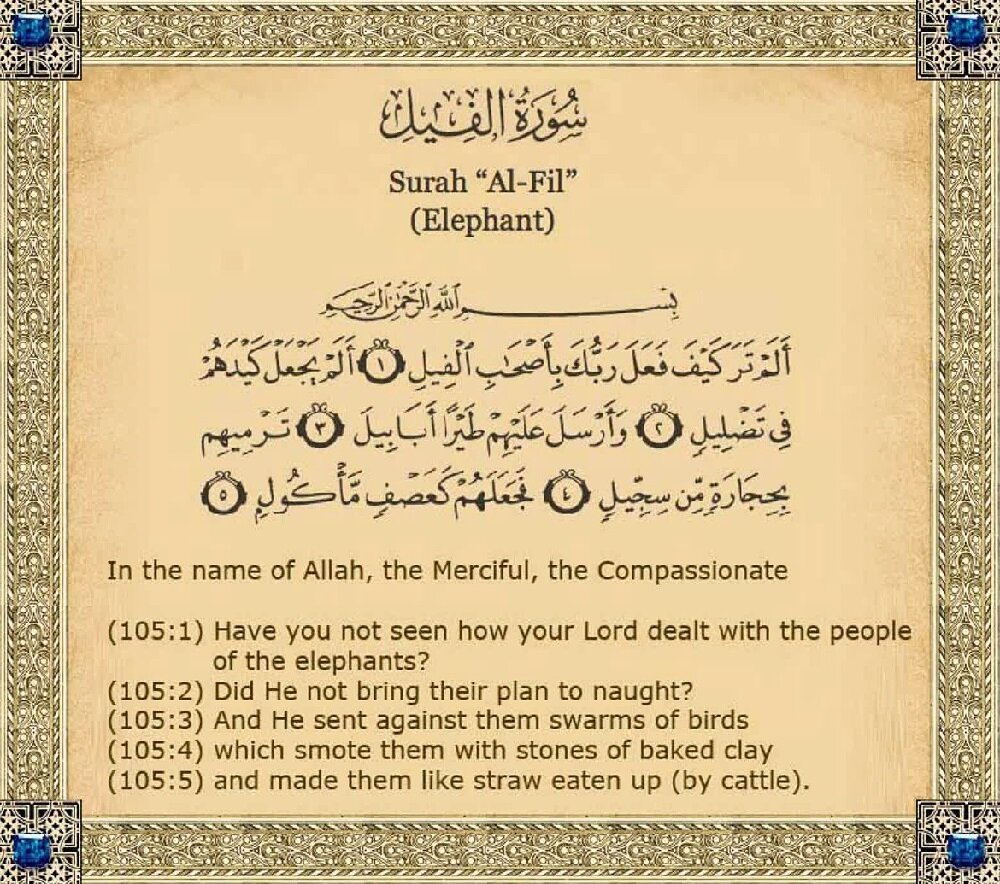
The sections of this article are:
1- The Glorious Quran’s Claims and the meanings of the Key Words.
(a)- The History of Noble Surah 105.
(b)- The Meanings of the Key Words in the Noble Surah.
(i)- What does Ababeel (أبابيل) mean?
(ii)- What does Sijjeel (سجيل) mean?
(iii)- What does Asfin Maa’kul (كعصف ماكول) mean?
2- The Overwhelming Scientific Miracles of the Glorious Quran.
3- Conclusion.
1- The Glorious Quran’s Claims and the meanings of the Key Words:
Let us look at Noble Surah (Chapter) 105:

(a)- The History of Noble Surah 105:
The incident of Abraha Al-Ashram, king of Abyssinia, attacking Mecca to destroy the Kaaba, and to change its location over to his kingdom to draw the annual pilgrims of Arabia to come to his kingdom instead, is a locally (in Arabia) documented historical fact. It is also well documented that his attack and mission were a failure. By the way, king Abraha’s attack on Mecca happened shortly before the birth of Prophet Muhammad, peace be upon him. The following articles clearly and indisputably prove this:
First Evidence from a NON-Muslim sources:
This article is in PDF Format. It has a well documented research that prove Islam’s claims and explains that Abraha invasion to mecca failed due to a smallbox disease pandemic too.
Second Evidence:
Saudis retrace route of Abraha’s army that came to destroy Kaaba
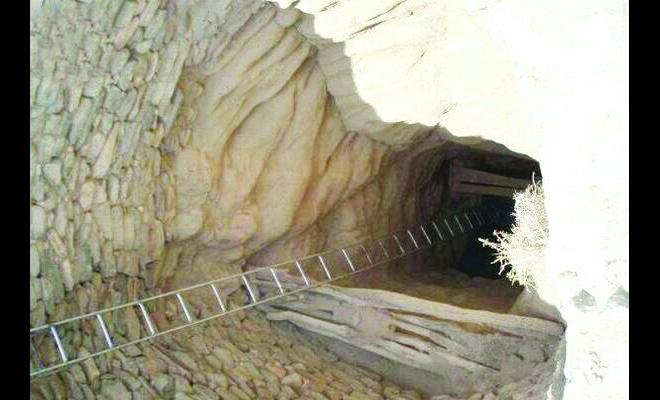
A group of young Saudi history enthusiasts has retraced the path of the People of the Elephant who tried to destroy the Holy Kaaba centuries ago.
The Holy Qur’an, in a short chapter, briefly refers to the story of the army of elephants led by Abraha Al-Ashram, who was a governor of Yemen. God destroyed Abraha and his army which included 13 elephants, by sending flocks of birds that dropped small stones on them.
“There never fell a stone on a soldier except it dissolved his flesh and burst it into pieces … Abraha Al-Ashram fled while his flesh was bursting into pieces and died on the way back to Yemen,” said the 14th century scholar Ibn Kathir, an authentic Qur’an commentator.
During their tiring journey across mountains and rough terrain, the young Saudi men took photographs of important landmarks, beginning from north of Najran, to the east of Asir, and then east of Baha.
Some of the most important historical sites along the way included inscriptions of elephants on rocks in the Al-Qahr Mountain, southeast of Tathlith; an old well in Hafaer, east of Asir; and a paved road near Kara in Aqeeq principality in the Baha region.
Mohammed Al-Amry, head of the geology department at King Saud University, said he had seen the path of Abraha and his army in Tathlith and Baha. “The army had passed the Arabian shield region comprising rocks and there were writings in the Humairiya language on some mountains,” he said.
According to historical Islamic sources, Abraha, who was a Christian, had thought of building a church similar to the Kaaba in Sanaa. He wanted the Arabs to perform the pilgrimage in Sanaa instead of Makkah, with the intention of diverting trade and benefits to Yemen. He presented the idea to the then king of Ethiopia who agreed to it.
Abraha built the church but the Arabs refused to come for pilgrimage in Sanaa. This infuriated him, prompting him to form an army to invade Makkah and demolish the Kaaba. He defeated all Arab armies on the way until he reached Makkah where he was attacked by the flocks of birds sent by the Almighty.
Third Evidence:
Ethiopian Attack on Mecca led by Abraha coming from Yemen:
Abraha (Ge’ez: አብርሃ) (also spelled Abreha, died after CE 570;[1] r. 525–at least 553[2]), also known as Abrahah al-Ashram (Arabic: أَبْرَهَة ٱلْأَشْرَم), was an Aksumite army general, then the viceroy of South Arabia for the Kingdom of Aksum, and later declared himself an independent King of Himyar.[3] Abraha ruled much of present-day Arabia and Yemen from at least 531–547 CE to 555–570 CE.[4][5]
Abraha Abraha was a Christian military leader on Yemen, Yemen was politically under Ethipea and was appointed by Ethiopian Ruler at the time. Abraha tried to build a huge chruch and this is why he wanted to Destry Kaba in Mekkah. Historically
This event is very famous and had happend in the same year as the birth of the Prophet Muhammed, Peace Be Upon Him (PBUH) (the year 571). Although the Prophet PBUH was not born during this event.
The begining of this event actually goes back further to the year 523. A Jew named Dhu Nawas campaigend against the Christian of Najran, with the aim of converting them to Judaism. Due to their refusal Dhu Nawas had the Christians thrown in a ditch and then set them on fire.
This is the reason for the second conquest of Yemen by Ethiopia (Abyssinia). The Roman Christians helped the Ethiopian Christian state to go against the Arabs. They assembled a fleet of 70,000 warriors to help the Ethiopian’s. Under the leadership of Eriat they succeded in the year 525.
Eriat was given rulership of Yemen untill he was assasinated by a fellow army leader, Abrahah. With the permision of the Ethiopian King, Abrahah was granted as the leader of Yemen.
It was Abrahah who aimed at destroying the Kaba.
At the approach of this grand army, the inhabitants of Makkah fled to the hills. The Ethiopian army was approuching from the direction of Taif.
Upon the army were grand elephants. When they came close birds flew over Abrahah’s army and dropped rocks frim their beaks. The elephants began to run away in panic and many of the soldiers died.
For more details Read these Pages of these books:
Al-Yaman ‘Abrat-Tarikh pp.77, 83, 124, 130, 157, 161
Tarikh Ardil-Qur’an 1/133
Tarikhul-Arab Qablal-Islam 105-151
The Sealed Nector pp48-49
The early life of Muhammad (PBUH) p6-7
Fourth Evidence:
Abraha, the year of the elephant, and the location of Mecca in Tom Holland’s “In the Shadow of the Sword”
Abraha, the year of the elephant, and the location of Mecca in Tom Holland’s “In the Shadow of the Sword”
So I’ve finished reading Holland’s book on the origins of Islam and I have to say I am not very impressed. I’ve revised my goals a bit and I will no longer be doing a point-by-point refutation of his book since much (as Holland himself admits) is speculatory, far too broad to refute directly and simply does not require much work to see why he is wrong in his main ideas. The origins of Islamic law and its development is also covered in the book (though rather amateurishly), but that will be discussed in a separate post as it is far too big and too important not to have a post on its own.
The location of Mecca
One of the main arguments in Holland’s book which I would like to refute is his ideas on the ‘original’ location of Mecca. Holland believes that the current Mecca, located near Yathrib, South arabia, is not the original place of its existence. It was actually in Palestine, and subsequently there was a great conspiracy by the Ummayyads to move the location and hide all the proof of its previous place of standing.
Most of his supporting points are not new and have been found in older (often times outdated) works such as those of the late Patricia Crone. There is currently a growing library of early Islamic inscriptions that help us place the early Muslim community within the vicinity of Mecca[1], unfortunately however they cannot be used to prove that Mecca was inhabited by the early Muslims as Holland does state that Muslims did somehow end up in Medina.
Thus the inscriptions would be the result of existence of a Medinan Muslim community and not necessarily a Meccan one. My positive argument for the original location of Mecca being correctly identified by the Islamic tradition will thus be a little less direct, consisting of two parts:
1. Pre-islamic inscriptions indirectly identifying the location of Mecca (this post)
2. The absurdities of Holland’s argument. (next post)
Part 1: Pre-islamic inscriptions indirectly identifying the location of Mecca
‘Am al-Fil: The year in which the Yemenite Christian king Abraha is said to have tried to attack Mecca to destroy the Ka’ba, in an attempt to divert pilgrimage from the Meccan shrine to his own great cathedral in Yemen[2]. The name, meaning “Year of the Elephant”, refers to Abraha’s usage of war elephants in his army which he led towards the Quraysh at Mecca.
The story is alluded to in the Qur’an in Surah al-Fil and its continuation, Surah Quraysh:
1 Do you not see how your Lord dealt with the army of the elephant? 2 Did He not utterly confound their plans? 3 He sent ranks of birds against them, 4 pelting them with pellets of hard-baked clay: 5 He made them [like] cropped stubble.
1 [He did this] to make the Quraysh feel secure, 2 secure in their winter and summer journeys. 3 So let them worship the Lord of this House: 4 who provides them with food to ward off hunger, safety to ward off fear.
The story alluded to here is undoubtedly the events in the Year of the Elephant. Commentators are absolutely unanimous in this regard[3]. One may still doubt whether these Qur’anic passages really do allude to ‘Abraha’s march towards Mecca. However, there is non-Qur’anic pre-islamic poetry that reports the same story that Muslim exegetes provide in their explanation of these verses.
For example, in the kitaab al-hayawaan by al-Jahiz, a poem by Abu Qays Sayfi praises God for His help on “the day of the elephant of the Abyssinians”[3], recalling that the elephant simply stopped dead in his tracks and would not advance despite being tortured. Then “God sent a wind bringing a shower of pebbles (ḥāṣib) from above”[4]. Rubin notes that the vocabulary of the poem is distinctly unqur’anic[5].
Infact, the poem has different themes to that of the Qur’anic account: The Qur’an, as with recounting other pre-islamic occurrences, spins it into a cautionary tale and rhetorical prose to convince the audience of the magnificence of God.
To scholars, this indicates that Abu Qays’ poetry is independent from the Qur’an. It is very likely that the poem is pre-islamic.
It is important to note that the same poet also identifies this incident with “Abu Yaksum”[6] – none other than Abraha himself. This is significant- there is already enough similarity between the pre-islamic poem and Surah al-fil to realize that they are talking about the same event (due to an elephant being involved and an army being wiped out by stones from the sky). Thus, it obviously follows that both versions of the story (Qur’anic and pre-islamic) are speaking about an attack on the Quraysh by the Yemenite king Abraha.
What I would like to drive home at this point is that now we have Arabic poetry originating decades after the death of Abraha, authored by and for the Arabs which were contemporary with the incident, if not from the following generation.
The Quranic account is independent from the poem, providing an added level of attestation to the historical account; again, written for Arabs that would have probably been children of those who lived even as Abraha led a campaign against Mecca. The story is both early and multiply attested. If we ignore the miracle story, there is little reason for a historian to deny that the expedition occurred*.
Other supporting evidence can be found in South Arabian inscriptions depicting war elephants[7]:
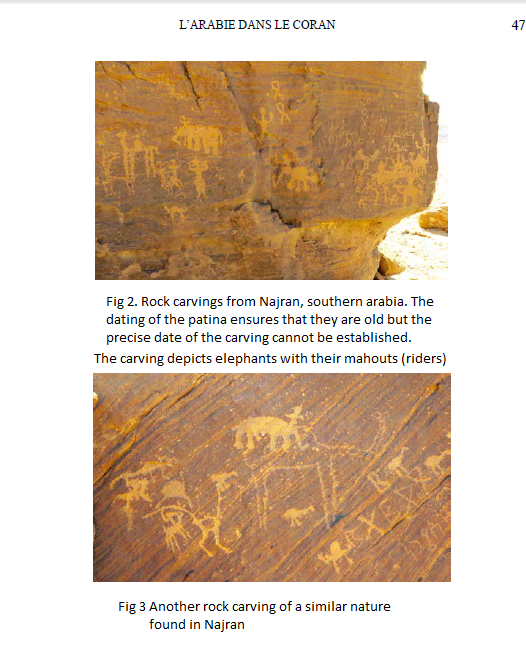
The inscriptions are significant because Abraha’s army would be the only one in the area to parade war elephants[8].
From this discussion, we can infer that:
1. The Qur’an is reporting a pre-Islamic event that must have actually happened some time during Abraha’s reign, meaning that the generation before the Prophet’s own[9].
2. Abraha campaigned with war elephants in the South Arabian region.
After establishing these two points, it is now possible to see how Holland’s assertions do not coincide with the historical facts presented here.
Mecca in Palestine?
Holland places the ‘original’ location of Mecca in Mamre, Palestine. Palestine in the 6th century was situated in Byzantine land. The corollary? That Abraha must have attacked the Byzantine empire some time in the 6th century.
One only needs to be slightly familiar with 6th-century byzantine and Arabian history to know how this is plain and simply false. We can understand why the expedition of the elephant is absent from pre-islamic Jahili written tradition (plainly due to the fact that the writing was comparatively rare in the first place), however, an attack on Palestine would have been recorded at least by Roman sources.
Procopius, a byzantine historian living in Palestine during the reign of Abraha records his ascent to power over the Himyarites, as well some of his wars and political exploits during his reign[11]. Abraha’s supposed attack on Palestine goes unmentioned, however, his promise to Justinian to attack the Persians does not.
I believe in this case we can make a good argument from silence. Had the attack happened, Procopius would have written about it, if not some other roman historian.
Besides Procopius’s account, Abraha campaigning against the Byzantines simply seems unlikely. The latter is was a regional superpower sharing the same religion as that of Abraha, so unlike Islam’s conquest of Roman lands, there is no theological motive to challenge a natural alliance. This explains why Abraha aligned himself with the Byzantines against the Persians at one point[12].
On the other hand, an attack on a south Arabian Mecca simply seems much more plausible. Inscriptions indicating Abraha’s political and military might over this area are well known, some of which have been reproduced in this article. There is also the Murayghan inscription, reporting of an expedition sent by Abraha towards Taraban, 100km north of Ta’if[13], which is in the vicinity of the traditional location of Mecca.
Conclusion
Tom Holland’s proposal that Mecca was originally located at Mamre, Palestine cannot be correct because it contradicts known facts surrounding the expedition of the elephant. As there is good evidence for the expedition, it would entail that the Himyarite king marched against the Byzantines, which contradicts what we see in Roman historical records and also goes against common sense.
The next post in this series will insha’allah expose some of the dubious methods with which Holland draws his conclusions. I actually do believe that this next post will provide a stronger argument, as it draws from common objections (and not those of an amateur blogger, ie. me) against Crone’s (and therefore Holland’s) theories on early Islam. I did want to do something “different” though, and as far as I am aware the argument presented in this blog post is a novel one.
Bibliography
[1] A very useful web page collating these inscriptions is www.islamic-awareness.org/History/Islam/Inscriptions/
[2] For an overview of the traditional story, see “The Message of the Qur’an”. Muhammad Asad. See intro to Surah al Fil. Other reasons are proposed for the motives of the campaign, one of which is that some Arabs went and defiled the cathedral in Yemen which incited ‘Abraha’s anger.
[3] See entry for Abraha. Rubin, Uri. Encyclopaedia of Islam, 3rd ed.
[4] ibid.
[5] ibid. “These and other verses that al-Jāḥiẓ considers genuinely pre-Islamic (al-Jāḥiẓ, Kitāb al-Ḥayawān, 7:197–9) are indeed free of Qurʾānic vocabulary and style—even the description of the divine punishment lacks Qurʾānic phrases”
[6] ibid. It must be noted that the name is not Qur’anic, meaning that the poet must have had non-Qur’anic sources. This adds to the likelyhood of the poem being of Jahili origin.
* Scholars such as Rubin, Conrad and Robin have all argued for or have assumed the historicity of the campaign.
[7] Les Compagnons de l’Éléphant (Aṣḥāb al-Fīl ). Christian Robin. Published in Les origines du Coran, le Coran des origines. 2015. p47. I have roughly translated from french and edited in the captions.
[8] ibid.
[9] That of Abd Al-Muttalib- indeed, he is present in the traditional story of the expedition.
[10] See Brill’s Encyclopedia of Islam. Abraha marched against Persia
[11] Procopius, Histories of the Wars, Vol 1 and 2 accessable here: http://www.gutenberg.org/files/16764/16764-h/16764-h.htm
[12] ibid
[13] F.E Peters. Muhammad and the Origins of Islam. p88
Fifth Evidence
The Incident of Abraha attack on Mecca with his elephant was actually documented in the Pre-Islamic era Arabic poem.
Now, the pre-islamic poem also specifies who it was that was involved in the attack- “Abu Yaksum”. The scholars that I am quoting from all believe that this event has a historical core to it.
For further information on the story of this Christian campaign against Mecca a reference is made in al-Seerah al-Nabawiyyah. Below is a pre-Islamic poem from the same source that preserved the event by a person who had witnessed it. The poet Nufail bin Habeeb was there when the event took place and met with the fleeing soldiers of Abraha’s army who asked him the directions to Yemen:

The poem can be roughly translated as follows:
Greetings Rudainah (A female name) we have been pleased with an early morning view. We had received – a seeker of fire – from your side (the word Qabis is used for a person who seeks fire or wood to be used as a source of light at night) but he could not find anything here.
O Rudainah! if you have seen what we have seen near al-Muhasab (a location between Mecca and Mina) you would excuse me and not be saddened with what happened in the past between us. I thanked God when I saw the birds and I was afraid of stones that was thrown on us. And they (Abraha’s men) were asking about me (to show them the way) as if I was owing them some previous debts.[7]
For more Information please read this link for more Evidence
The breed and type of the elephant that Abraha rode was probably the North African elephant (Loxodonta africana pharaoensis)—now extinct, which had been used by the Carthaginians centuries before. Its original range extended across North Africa and down the grasslands of the Sudan.
Some have questioned the claim that elephants could not survive a long cross-desert sojourn because of their need for water. However, according to the parable, Abraha may have brought only a single elephant with him. His water bearers, oases, and wells along the northern march would have provided sufficient water for both the large army and its animal retinue, including at least one, but many elephants, and hundreds of horses, camels, and beasts of burden.
For More reading about the yera of the Elephant read here
The Ancient Greek Procopius of Caesarea Mentioned Abraha=Abramus who tried to invade Mecca clik here to read
Saudi refuses $4 million for stone that are mentioned in Chapter the Elephant
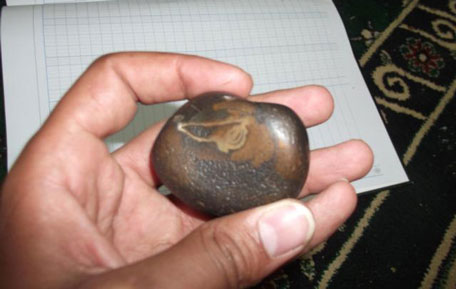
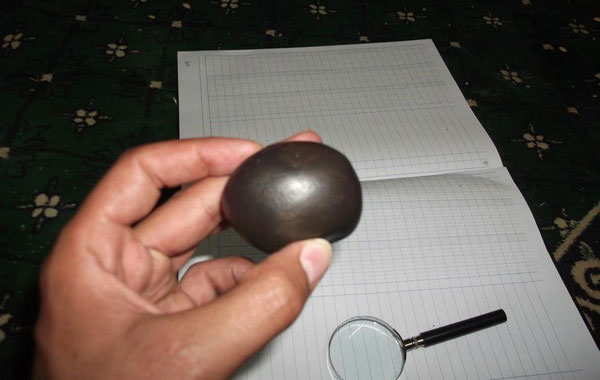
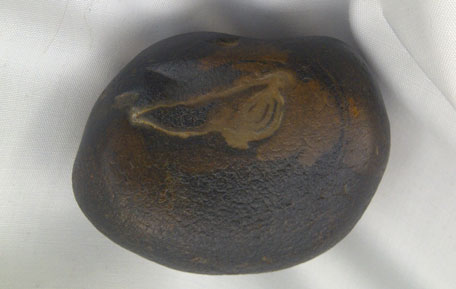
A Saudi man on a hunting trip in the rugged mountains near the border with Yemen stumbled across a little dark stone, which he instantly recognized as that mentioned in the holy Koran. A year later, he was offered $four million for the stone but he refused.
Saleh Musfer Al Gamdi said the stone, which carries drawings of birds and elephants, weighs 131 gm, exactly the same number of words in the Koran verse that mentioned the stone– “Surat Al Fil (elephant).”
According to that verse, God the Almighty sent Ababil birds to throw Sejil stones (pebbles of hell) to destroy an army led by Yemen’s warlord Abraha just before the advent of Islam to knock down Kaaba in Makkah, now the Moslems’ holiest shrine.
Gamdi said he found the hard black-grayish stone in the southern Jarb valley, previously known as the Green Wadi, where Abraha and his soldiers and elephants stayed for a period of time before heading for Makkah.
He said experts estimated that the stone dates back to nearly 1,442 years, adding that he found it just a day after dreaming of his father and grandfather.
“A year after I found the stone, I asked an Egyptian friend whose relatives work in the archeology field…they contacted me and asked me to send them pictures of that stone,” Gamdi said, quoted by the Saudi Arabic language daily Sabq.
“After a series of messages and phone calls, they told me they would buy the stone for $four million but I refused to sell it….a while later, the tourism department in Baha (southern Saudi Arabia) asked me to hand the stone over but I again refused.”
The story of Abraha begins when he feels envy of the town of Makkah in Saudi Arabia because Kaaba (House) was visited by many Arabs who wanted to make the pilgrimage every year before Islam. He has a great desire to destroy and divert Arab worshippers to Yemen, which has a large temple built by Abraha.
Before the offensive on Mecca, he first sent a messenger to inform them of his aims and desires. The messenger was suggested for the people of Mecca to perform their pilgrimage in Yemen only. If not, then the Kaaba will be destroyed.
Because they were disobedient, finally Abraha was really mad and ordered all troops to be getting ready to attack Mecca and destroy the Kaaba.
Abraha’s army had complete war equipment, armour, and the elephants that will be used to knock down kaaba. Abraha told the messenger that the purpose of attack is not intended to fight, but just wanted to destroy the Kaaba.
At that time Mecca residents, led by Abdul Muttalib could not do anything to stop Abraha. There was no choice but to surrender and give up.
Sometime before the arrival of Abraha’s army, Abdul Muttalib instructed his people to shelter and evacuate immediately behind the hill near Mecca.
Abraha was convinced that he will be able to destroy the Kaaba very easily. But what happens next? God’s help arrived according to the Koran. These birds threw many, many stones of baked clay at the elephants and the people, which led to their defeat and destruction before they manage to knock down Kaaba.
5- Also, according to Abdullah Yusuf Ali’s English translation Noble Surah 105:”This early Makkan Surah refers to an event that happened in the year of the birth of our Holy Prophet, say about 570 A.C. Yemen was then under the rule of the Abyssinians (Christians), who had driven out the Jewish Himyarite rulers.
Abrahah Ashram was the Abyssinian governor or viceroy. Intoxicated with power and fired by religious fanaticism, he led a big expedition against Makkah, intending to destroy the Ka’bah. He had an elephant or elephants in his train.
But his sacrilegious intentions were defeated by a miracle. No defence was offered by the custodians of the Ka’bah as the army was too strong for them. But a shower of stones by flocks of birds, destroyed the invading army almost to a man. The stones produced sores and pustules on the skin, which spread like a pestilence.” (The Meaning of the Holy Quran, Abdullah Yusuf Ali, Page 1699, ISBN: 0-91597-59-0)
So the following points are important to keep in mind:
1- The incident that Noble Surah 105 is talking about was not an ancient one. The Surah was revealed in Mecca and was revealed to the Meccans. It was virtually impossible for the Prophet of Islam to come up with some ridiculous tale to the people who have already witnessed the incident 40 years earlier. He would’ve been immediately dismissed as a liar.
2- Ample historical documentations, that even by Western historians today approve of, state that Abraha’s attack and mission was a big failure and was abruptly stopped.
3- There are eye witnesses to the birds attacking the army of Abraha and dumping stones on them.
4- The Kaaba was protected and as Allah Almighty Promised in the Glorious Quran, many will come to pilgrimage to it from all over the world every year.
(b)- The Meanings of the Key Words in the Noble Surah:
The following are the Arabic key words in the Noble Verses, and their analysis:
1- ابابيل (ababeel) means flight of birds, or a large amount of birds. According to Lisan Al-Arab Dictionary , ابابيل (ababeel) means:
(Arabic, from right to left)
وأَبَل يأْبِلُ أَبْلاً: غَلَب وامتنع؛ عن كراع، والمعروف أَبَّل. ابن الأَعرابي: الإِبَّوْلُ طائر ينفرد من الرَّفّ وهو السطر من الطير. ابن سيده: والإِبِّيلُ والإِبَّوْل والإِبَّالة القطعة من الطير والخيل والإِبل؛ قال: أَبابيل هَطْلَى من مُراحٍ ومُهْمَل وقيل: الأَبابيلُ جماعةٌ في تَفْرِقة، واحدها إِبِّيلٌ وإِبَّوْل، وذهب أَبو عبيدة إِلى أَن الأَبابيل جمع لا واحد له بمنزلة عَبابِيدَ وشَماطِيطَ وشَعالِيلَ. قال الجوهري: وقال بعضهم إِبِّيل، قال: ولم أَجد العرب تعرف له واحداً.
وفي التنزيل العزيز: وأَرسل عليهم طيراً أَبابيل، وقيل إِبَّالة وأَبَابيل وإِبالة كأَنها جماعة، وقيل: إِبَّوْل وأَبابيل مثل عِجَّوْل وعَجاجيل، قال: ولم يقل أَحد منهم إِبِّيل على فِعِّيل لواحد أَبابيل، وزَعم الرُّؤَاسي أَن واحدها إِبَّالة. التهذيب أَيضاً: ولو قيل واحد الأَبابيل إيبالة كان صواباً كما قالوا دينار ودنانير، وقال الزجاج في قوله طير أَبابيل: جماعات من ههنا وجماعات من ههنا، وقيل: طير أَبابيل يتبع بعضها بعضاً إِبِّيلاً
إِبِّيلاً أَي قَطيعاً خَلْفَ قطيع؛ قال الأَخفش: يقال جاءت إِبلك أَبابيل أَي فِرَقاً، وطير أَبابيل، قال: وهذا يجيء في معنى التكثير وهو من الجمع الذي لا واحد له؛ وفي نوادر الأَعراب: جاء فلان في أُبُلَّتِه وإِبالته أَي في قبيلته.
وأَبَّل الرجلَ: كأَبَّنه؛ عن ابن جني؛ اللحياني: أَبَّنْت الميت تأْبيناً وأَبَّلْته تأْبيلاً إذا أَثنيت عليه بعد وفاته.
Translation:
(a)- الأَبابيلُ جماعةٌ في تَفْرِقة The Ababeel is a dispersed group.
(b)- طير أَبابيل يتبع بعضها بعضاً إِبِّيلاً إِبِّيلاً أَي قَطيعاً خَلْفَ قطيع The birds of Ababeel are ones that follow each others, in large groups, in groups after groups, and they are right behind each others.
(c)- وطير أَبابيل، قال: وهذا يجيء في معنى التكثير And the birds of Ababeel is meant to show their large numbers.
2- سجيل (sijjeel) means (desert) rocks that are hard, sharp and/or made out of clay. According to Lisan Al-Arab Dictionary
سجيل (sijjeel) means:
(Arabic, from right to left)
والسَّجِيلُ الصُّلْب الشديد.
والسِّجِّيل حجارة كالمَدَر.
وفي التنزيل العزيز: ترْمِيهم بحِجارة من سِجِّيل؛ وقيل: هو حجر من طين، مُعَرَّب دَخِيل، وهو سَنْكِ رَكِل (* قوله «وهو سنك وكل» قال القسطلاني: سنك، بفتح السين المهملة وبعد النون الساكنة كاف مكسورة.
وكل، بكسر الكاف وبعدها لام) أَي حجارة وطين؛ قال أَبو إِسحق: للناس في السِّجِّيل أَقوال، وفي التفسير أَنها من جِلٍّ وطين، وقيل من جِلٍّ وحجارة، وقال أَهل اللغة: هذا فارسيٌّ والعرب لا تعرف هذا؛ قال الأَزهري: والذي عندنا، والله أَعلم، أَنه إِذا كان التفسير صحيحاً فهو فارسي أُعْرِب لأَن الله تعالى قد ذكر هذه الحجارة في قصة قوم لوط فقال: لنُرْسِل عليهم حجارةً من طين؛ فقد بَيَّن للعرب ما عَنى بسِجِّيل.
ومن كلام الفُرْس ما لا يُحْصى مما قد أَعْرَبَتْه العربُ نحو جاموس ودِيباج، فلا أُنْكِر أَن يكون هذا مما أُعْرِب؛ قال أَبو عبيدة: من سِجِّيل، تأْويله كثيرة شديدة؛ وقال: إِن مثل ذلك قول ابن مقبل: ورَجْلةٍ يَضْرِبون البَيْضَ عن عُرُضٍ، ضَرْباً تَوَاصَتْ به الأَبْطالُ سِجِّينا قال: وسِجِّينٌ وسِجِّيلٌ بمعنى واحد، وقال بعضهم: سِجِّيل من أَسْجَلْته أَي أَرسلته فكأَنها مُرْسَلة عليهم؛ قال أَبو إِسحق: وقال
بعضهم سِجِّيل من أَسْجَلْت إِذا أَعطيت، وجعله من السِّجْل؛ وأَنشد بيت اللَّهَبي:مَنْ يُساجِلْني يُساجِلْ ماجدا وقيل مِنْ سِجِّيلٍ: كقولك مِن سِجِلٍّ أَي ما كُتِب لهم، قال: وهذا القول إِذا فُسِّر فهو أَبْيَنُها لأَن من كتاب الله تعالى دليلاً عليه، قال الله تعالى: كَلاَّ إِن كتاب الفُجَّار لَفِي سِجِّينٍ وما أَدراك ما سِجِّينٌ كتابٌ مَرْقومٌ؛ وسِجِّيل في معنى سِجِّين، المعنى أَنها حجارة مما كَتَب اللهُ تعالى أَنه يُعَذِّبهم بها؛ قال: وهذا أَحسن ما مَرَّ فيها عندي.
Translation:
(a)- السَّجِيلُ الصُّلْب الشديد The Sijjeel is the hard and the tough.
(b)- سِجِّيل؛ وقيل: هو حجر من طين Sijjeel is a rock from dried mud.
(c)- من سِجِّيل، تأْويله كثيرة شديدة From Sijjeel means it is in great quantities and it is tough.
3- كعصف ماكول means like an empty field of stalks and straw, (of which the corn) has been eaten up. According to Lisan Al-Arab Dictionary كعصف ماكول means:
(Arabic, from right to left)
وقوله تعالى كعَصْف مأَْكول، له معنيان: أَحدهما أَنه جعل أَصحاب الفيل كورق أُخذ ما فيه من الحبّ وبقي هو لا حب فيه، والآخر أَنه أَراد أَنه جعلهم كعصف قد أَكله البهائم.
وروي عن سعيد بن جبير أَنه قال في قوله تعالى كعصف مأَكول، قال: هو الهَبُّور وهو الشعير النابت، بالنبطية.
وقال أَبو العباس في قوله كعصف قال: يقال فلان يَعْتَصِفُ إذا طلب الرزق، وروي عن الحسن أَنه الزرع الذي أُكل حبه وبقي تِبْنه؛ وأَنشد أَبو العباس محمد بن يزيد: فصُيِّروا مِثْلَ كعَصْفٍ مأَْكولْ أَراد مثل عصف مأْكول، فزاد الكاف لتأْكيد الشبه كما أَكده بزيادة الكاف في قوله تعالى: ليس كمثله شيء، إلا أنه في الآية أَدخل الحرف على الاسم وهو سائغ، وفي البيت أَدخل الاسم وهو مثل على الحرف وهو الكاف، فإن قال قائل بماذا جُرَّ عَصْف أَبالكاف التي تُجاوِرُه أَم بإضافة مثل إليه على أَنه فصل بين المضاف والمضاف إليه؟
فالجواب أَن العصف في البيت لا يجوز أَن يكون مجروراً بغير الكاف وإن كانت زائدة، يدُلّك على ذلك أَن الكاف في كل موضع تقع فيه زائدة لا تكون إلا جارَّة كما أَنَّ من وجميع حروف الجرّ في أَي موضع وقَعْن زوائد فلا بد من أَن يجررن ما بعدهن، كقولك ما جاءني من أَحد ولست بقائم، فكذلك الكاف في كعصف مأْكول هي الجارَّة للعصف وإن كانت زائدة على ما تقدَّم،
فإن قال قائل: فمن أَيْنَ جاز للاسم أَن يدخل على الحرف في قوله مثل كعصف مأْكول؟ فالجواب أَنه إنما جاز ذلك لما بين الكاف ومثل من المُضارَعة في المعنى، فكما جاز لهم أَن يُدخلوا الكاف على الكاف في قوله: وصالِياتٍ كَكما يُؤَثْفَينْ لمشابهته لمثل حتى كأَنه قال كمثل ما يؤثفين كذلك أَدخلوا أَيضاً مثلاً على الكاف في قوله مثل كعصف، وجعلوا ذلك تنبيهاً على قوَّة الشبه بين الكاف ومثل.
…….
و{كعَصْفٍ مأكولٍ}، أَي: كزَرْعٍ أُكِلَ حَبُّهُ وبَقِيَ تِبْنُهُ
Translation:
(a)- كعَصْف مأَْكول، له معنيان: أَحدهما أَنه جعل أَصحاب الفيل كورق أُخذ ما فيه من الحبّ وبقي هو لا حب فيه، والآخر أَنه أَراد أَنه جعلهم كعصف قد أَكله البهائم Like the Ka’aasfin Maa’kool has two meanings:
The first one is that the companions of the elephant were like the plants which its seeds where taken from it, and they were left without seeds.
The other meaning is that many of them were left dead for the wild animals to eat them.
(b)- و{كعَصْفٍ مأكولٍ}، أَي: كزَرْعٍ أُكِلَ حَبُّهُ وبَقِيَ تِبْنُهُ Like the Ka’aasfin Maa’kool means it is like the plant which seeds were eaten.
4- الم تر (have you not seen). Throughout the Glorious Quran, Allah Almighty had said this statement on a number of occasions to Prophet Muhammad, peace be upon him, when He, the Almighty, Gave him a vision of a historical event that happened in the past, or of something that is occurring in the world of the unseen, or a vision of something current that was not known to the Believers.
The following Noble verses from the Quran clearly prove this:

2- The Overwhelming Scientific Miracles of the Glorious Quran:
The overwhelming Scientific Miracles of the Glorious Quran do certainly serve as further proofs and assurances that the Miracle of the birds sent by Allah Almighty to protect the Kaa’bah from being forever destroyed did occur.
The Glorious Quran is the only Book on the face of this earth today that is:
1- 100% Preserved.
2- 100% in perfect harmony and agreement with modern-day Science.
3- 100% the True and Pure and Living Holy Word and Revelation of Allah Almighty.
3- Conclusion:
Given the archeological discoveries above, and the Glorious Quran’s STUNNING Scientific and Numerical Miracles, there is no question that the Miracle of the birds protecting Mecca is quite feasible. Many people witnessed this Miracle happening when the Prophet was days old.
The Prophet, therefore, could not have dared to come up with some false tale to the Meccans if the story didn’t indeed happen. But because it happened, it was widely accepted by the people of Mecca.
Indeed, all Praise and Glory are due to Allah Almighty alone for making the Noble Quran be the Perfect and Everlasting Miracle, for us humans, out of all of His Divine Miracles! And may Allah Almighty send His Peace, Mercy and Blessings upon our Beloved and Blessed Prophet, Teacher and Role Model, Muhammed. Ameen.